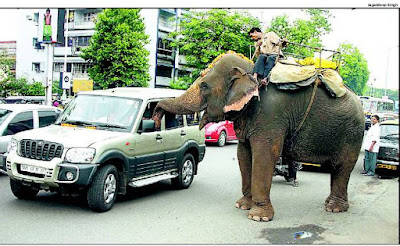The sight of a majestic elephant, the National Heritage Animal of India, reduced to begging on a crowded urban street is indeed deeply poignant, as you describe. These animals, symbols of strength and divinity, are often seen crisscrossing busy markets or standing by vehicles, stretching out their trunks for alms—a practice driven by the financial desperation of their mahouts.
 |
| Colorful Indian elephants gracing the street |
 |
| old image Indian street elephant, Delhi theguardian.com/ |
For centuries, elephants were indispensable in India, utilized for demanding tasks like logging, construction, military transport, and royal hunts (Shikar). Their extraordinary intelligence, strength, and loyalty made them revered working animals. However, with increased mechanization, their traditional employment has plummeted. For private owners, an elephant has shifted from a valuable asset to a crushing financial liability, costing a fortune daily for food and upkeep. The sad result is the rise of the "begging elephant," an animal forced to endure the physical and psychological toll of an unnatural urban life. Crowded, noisy, polluted streets are a drastic contrast to their natural habitat—vast, lush green open ranges with water holes. Forced to walk and stand on hot, hard concrete, many elephants suffer from severe, chronic foot and joint injuries. They are often malnourished and show signs of psychological distress like swaying and head-bobbing. Furthermore, many captive elephants are first captured from the wild and subjected to the brutal 'phajaan' or "breaking of the spirit" process, involving beatings and torture to force obedience.
 |
| www.cartoonstock.com |
Above images: Once in a while we are accustomed to seeing elephants begging on the streets in some urban semi-urban areas. It is a sad sight to see a majestic, but weary-looking jumbo taking orders from a man and begging alms for his big belly and to fill up his master's (Mahout) wallet. Now strict laws in force to allow walking elephants on the street without permission.
 |
| Indian elephant, bucks from the car occupants? .timesofindia.com |
Above images: Once in a while we are accustomed to seeing elephants begging on the streets in some urban semi-urban areas. It is a sad sight to see a majestic, but weary-looking jumbo taking orders from a man and begging alms for his big belly and to fill up his master's (Mahout) wallet. Now strict laws in force to allow walking elephants on the street without permission. There are permitted elephants to carry tourists around the forts, etc. in the state of Rajasthan........
Indian law provides a strong basis for the protection of elephants, yet enforcement gaps remain. The Asian Elephant is a Schedule I protected species under the Wildlife Protection Act (WLPA), 1972. This status prohibits hunting, poaching, trafficking, and illegal trade, with a maximum penalty of up to seven years imprisonment. While commercial sale is prohibited, the WLPA has historically had an anomaly allowing the legal private ownership of elephants. This exception, combined with weak regulation on transfer, has created a fertile ground for illegal capture from the wild and unregulated movement across state borders. Animal welfare organizations regularly report that begging and temple elephants are often held illegally, lacking proper ownership certificates, and are moved across states without the required Transit Permits. There are continuous appeals for a complete ban on the use of elephants for begging and entertainment.
The ultimate solution involves removing these majestic animals from the streets and ensuring their long-term welfare. The government, through Project Elephant, partners with NGOs like Wildlife SOS and PETA to rescue abused captive elephants. These rescued elephants, having lost their 'wild spirit,' cannot be re-introduced to the wild and instead require lifelong care in specialized, accredited rehabilitation centers and sanctuaries. The focus must also be on the mahouts, who, hard-pressed for money, are often victims of poverty themselves. Rehabilitation efforts need to be comprehensive, finding ways to offer alternative, sustainable livelihoods to mahouts and their families. The struggle to end elephant begging continues, driven by the belief that these highly intelligent, keystone species deserve to live free from suffering, dignity intact.
https://forcechange.com/144735/rescue-indias-begging-elephants
https://www.theguardian.com/world/2014/oct/26/end-road-new-delhi-elephants-india









